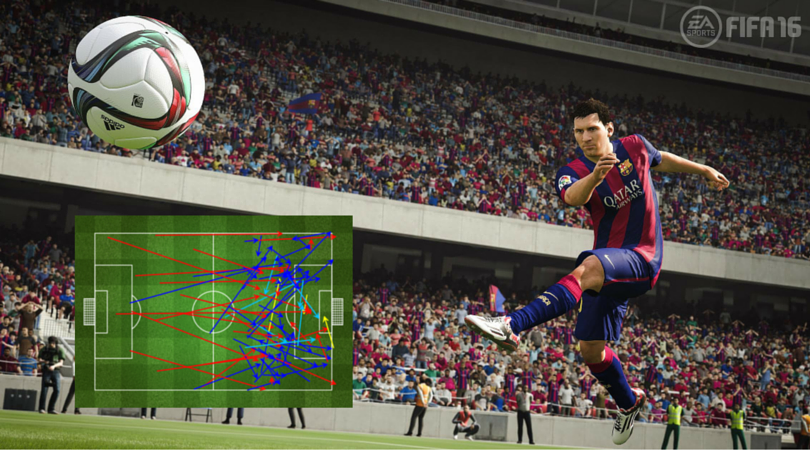7 essential tips and tricks you need to know for FIFA 16
Games guru James Price provides some essential advice on EA's brilliant virtual recreation...
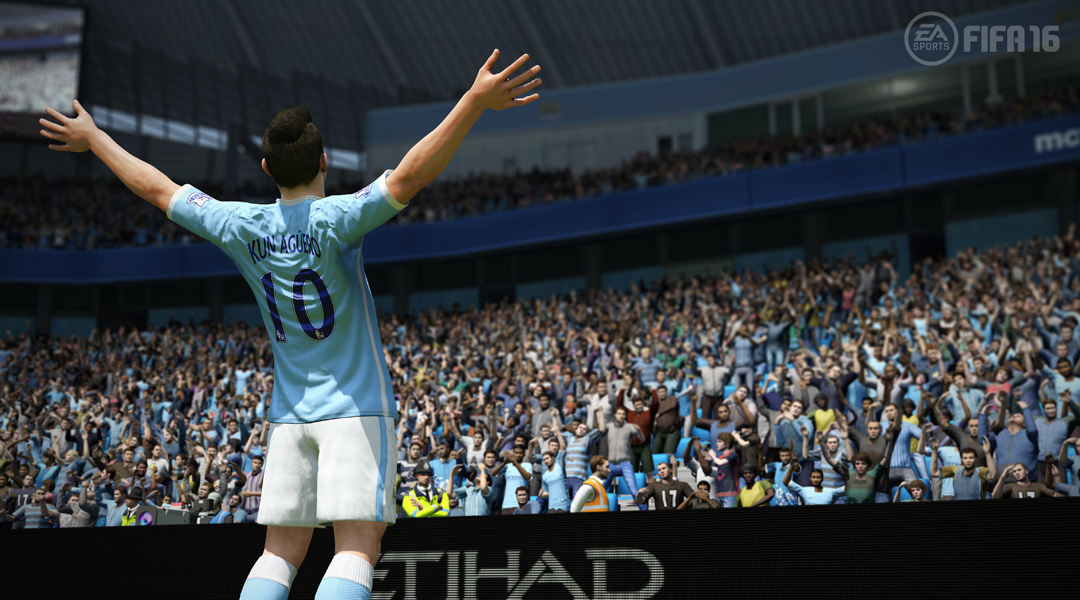
Those who refused to sacrifice their purist short-game principles in FIFA 15 have reason for cheer – and, potentially, no small measure of smugness over the coming weeks.
After a year of kick and rush being the default (and alarmingly effective) tactic for most online regulars, FIFA 16’s stand-out feature is a heightened emphasis on midfield play. Bypassing the middle of the park with preposterous lofted through-balls is out; patient probing and intelligent movement are in. After an unhealthy number of hours with the FIFA 16 demo in recent days, it’s fair to speculate that many players will need to completely rebuild their style of play from the ground up.
Before we continue, a caveat: in a game where minute adjustments to global variables that govern player pace, strength and agility can completely transform the way that the simulation plays, we can’t be entirely sure that the FIFA 16 that we play in the demo will be the same FIFA 16 we’ll play at launch on the 24th (22nd in North America), let alone what manner of fixes and fine-tuning we might find in future patches.
Dele Alli tells FFT that he's the best at FIFA 16 at Spurs
We’ve witnessed at least one version of FIFA be transformed by a major post-release rebalancing update in recent years, and there’s no guarantee that the development team will keep their faith in this more intricate and involved style of play if it appears that the majority can’t get to grips with it.
For now, though, it certainly seems that FIFA 16 is shaping up to be a more methodical, measured simulation than its predecessor. With that in mind, we’ve put together a collection of tips that will help you hit the ground running once the full game is available...
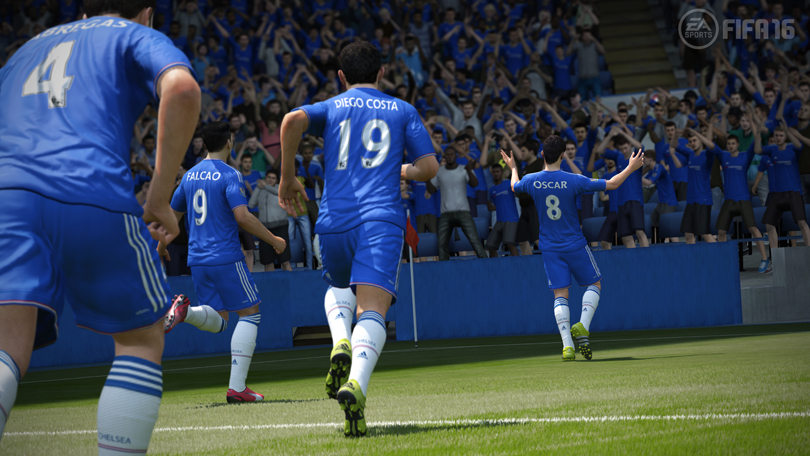
1) Mix up your passing
Get FourFourTwo Newsletter
The best features, fun and footballing quizzes, straight to your inbox every week.
Now that AI-controlled players work harder to maintain their shape, exclusive use of basic short passes (X button/A button) will lead to one-dimensional build-up play. To drag capable opponents out of position and create space, you’ll need to employ more varied styles of distribution.
Though it takes a bit of practice, use of short through-balls (triangle button/Y button) to roll the ball into space ahead of a nearby team-mate, rather than just knocking it into their feet, can enable you to open up new angles for subsequent passes. The through-ball isn’t just a method of playing slide-rule passes for strikers or wingers to chase – it adds texture to a passing move. You can also use it to draw players behind the ball into play without completely losing momentum. Another benefit is that the risk of a poor first touch is rarely an issue when a player is running onto a rolling ball, unlike passes made to feet.
The new drilled pass warrants a lot of practice, as it’s a potentially momentous addition
Pay close attention to the way that formations move in accordance with where the ball is. If you find that one side of the pitch is becoming congested, switch the play with a lofted crossfield pass (hold square button/X button until bar reaches required level – three-quarters usually suffices) or the new drilled pass (R1+X button/RB+A button) to quickly exploit the space that has opened up on the opposite touchline.
The latter move warrants a lot of practice, as it’s a potentially momentous addition. Passes played in this fashion are pinged into feet with far greater speed than the standard delivery, which makes it possible to vary the pace of your build-up play more than ever before. Be warned that even top players can struggle to trap these cleanly unless you quickly reorient them in advance. That said, we’re finding that poor first touches sometimes lead to beneficial bounces that completely fool a nearby marker. There may be more to this passing style than simply moving the ball from point A to point B at greater speed…
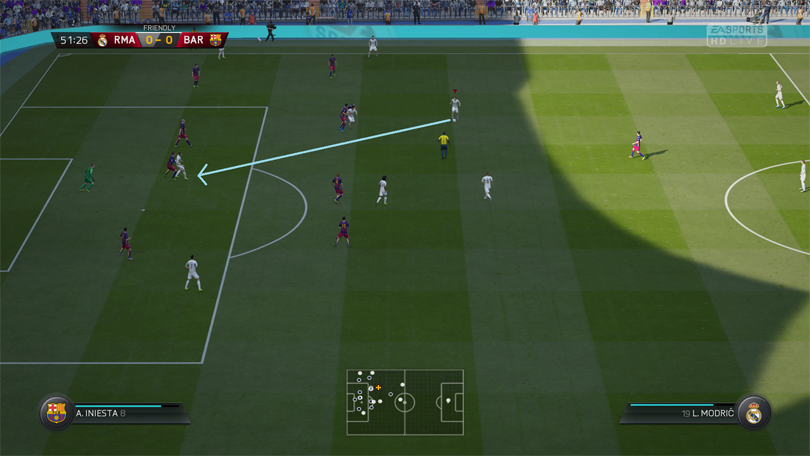
Expect to see this scenario frequently in online games: the new driven pass (R1/RB+X button/A button) pinged into strikers lurking in the box. They’re not easy to control, but bad touches can still lead to lucky breaks.
2) Create your own movement
Fluid passing moves aren’t just about how you stroke the ball around – movement is just as important. AI-controlled players will regularly make automatic runs, and these can help unlock a stubborn defence if you can spot them in time and find the right pass.
Equally, they can lead players into cul-de-sacs, or you might find runners are being consistently picked up by markers. In these instances, there are three reliable ways to create off-the-ball runs.
1. While facing a team-mate with the player under your control, hold left stick in the appropriate direction and tap L1/LB to instruct him to make a forward run. We illustrate the use of this below.
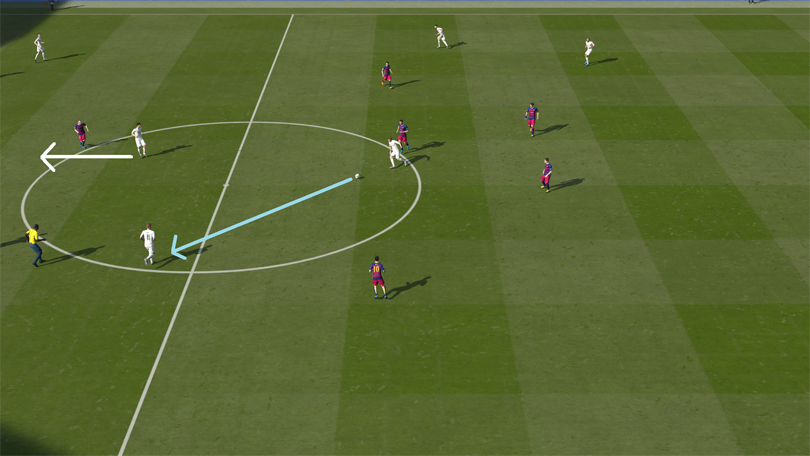
First, we set up a forward run by Rodriguez with L1/LB and left stick while controlling Modric, then play a simple pass to Kroos.
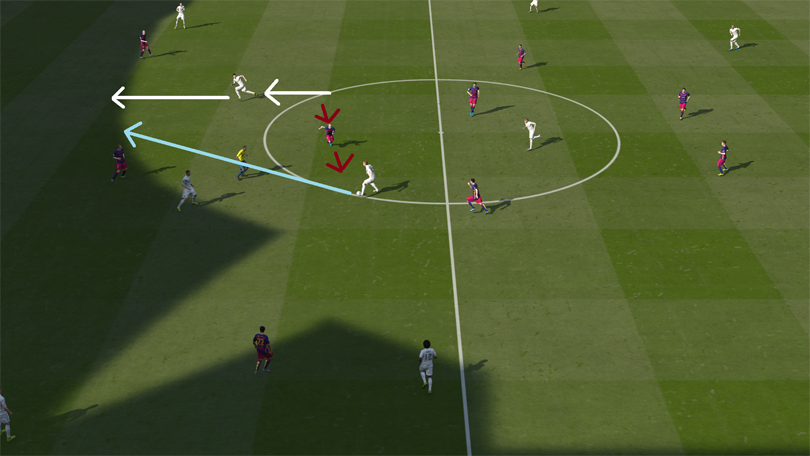
No more than a crowd roar later, we see that Iniesta has let Rodriguez go in an attempt to close down Kroos. Benzema has dropped deep, bringing his defender with him... opening up a simple through-ball to provide the sprinting Colombian with a clear run on goal.
2. Press L1/LB while playing a short pass (X button/A button) to initiate a one-two pass. After the second player receives the ball, there’s no obligation to make a return pass immediately, or even at all – you can make a decision in accordance with how penetrating the run is. If a marker picks up your man, this may open up space elsewhere. A couple of passes later, you might suddenly find that the runner is in a great spot as they drift back to their natural position.
3. Last, but not least, you can tap L2/LT just as (or fractionally after) a pass is played to instruct the player in question to make a forward run. This is great for setting up dummy runs to drag defenders around, or for those instances where you notice space opening up at the last moment.
3) If in doubt, play the wings
With teams more inclined to defend in depth, moving the ball through the centre of the pitch often necessitates patience and no small amount of finesse. If you can’tget the right kind of movement between the lines to create space in your opponent’s half, or would like to engineer a faster style of play, shift the focus to the wings. If you can time them to match a burst forward by a winger or overlapping full-back, low but powerful through-balls (L1+Triangle button/LB+Y button) played close to the sidelines can set up an opportunity to deliver the ball into the box. It’s not particularly hard to lure AI-controlled full-backs out of position to clear a path; your mileage will vary against human opponents, though. We’ve heard word that many players are struggling to deal with crosses, so expect this to be the go-to strategy in online matches.
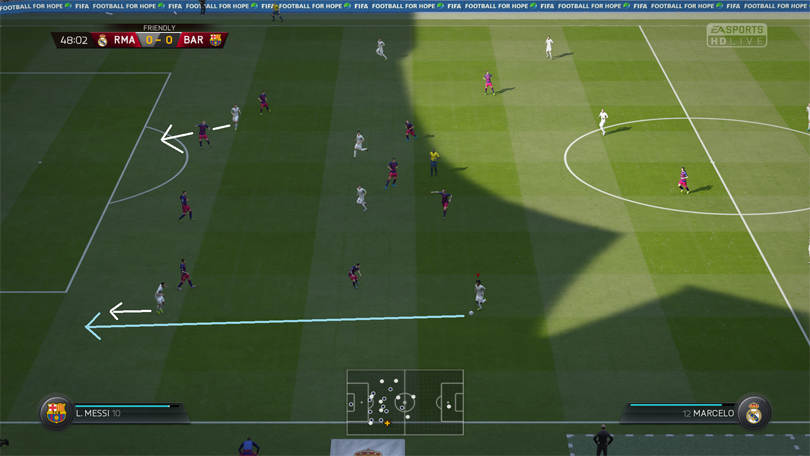
Teams that go narrow while defending (either temporarily, or as a chosen tactic) will be given a torrid time by players who favour wing play. If you have a suitably large TV and don’t mind the zoomed-out view, the “Co-op” camera (used here) can give you an edge over opponents who prefer the default perspective.
4) Press smartly
Backlines will now maintain a better shape, with individual centre-backs less likely to pause only to lay down a welcome mat before they sprint out of position
Though you still use the same broad set of controls and moves to defend in FIFA 16, it’s a very different experience to last year’s game. Backlines will now maintain a better shape, with individual centre-backs less likely to pause only to lay down a welcome mat before they sprint out of position. Midfielders are also much improved in this respect, being quicker to get behind the ball (a behaviour almost completely lacking in their FIFA 15 equivalents).
With AI-controlled players having a better general appreciation of space, one of the best ways to keep things tight is to pick the right player to apply pressure on the opponent carrying the ball when there’s no immediate danger. Use of the classic L1/LB 'change player' function isn’t appropriate here – use right stick to select a player with greater precision.
If you’re defending in the central third of the park, a good rule of thumb is to track back with the closest striker; if play is focused on the edge of your area, choose a midfielder to press. The point of this is to have the line of players behind the ball hold their position, making it harder for your opponent to find openings. This style of defending can be very effective after transitions – closing down from the front can provide time for the rest of your team to get back into position.
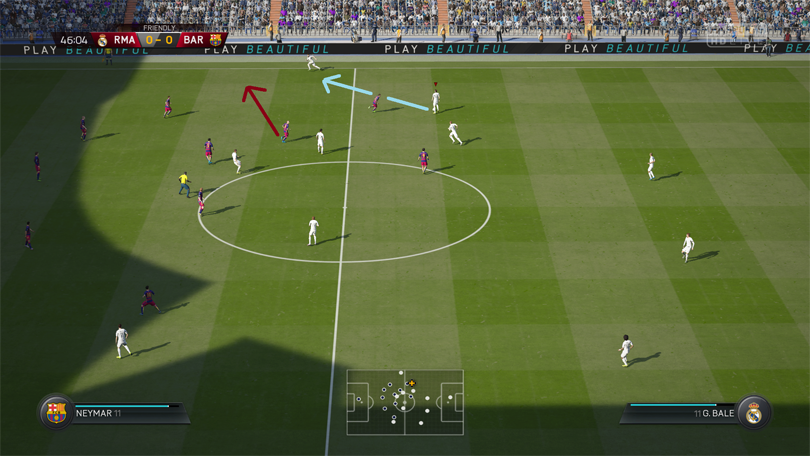
In this scenario, it’s an instinctive choice to select the full-back in anticipation of the inevitable pass along the wing. By switching to the closest available midfielder, though (in this instance, Iniesta), you can potentially apply pressure on the winger and leave your full-back to cover.
5) Get stuck in more
One thing that relatively few players realise is that close physical proximity and pressure can reduce the accuracy of passes, shots and crosses
As experienced players will already know, the manual tackle button (circle button/B button) can be used to tug shirts and apply contextual pressure to opponents in close proximity. From what we’ve seen in FIFA 16 so far, this is far more nuanced this year than in previous games. Use it with a strong holding midfielder against a lightweight No.10, for example, and you can expect to lever them off the ball without effort if you’re close enough. Steady tapping of the button will suffice to avoid committing a foul. Referees appear more inclined to let these tussles slide than in FIFA 15, though using them in the penalty area is a risk that you should avoid.
One thing that relatively few players realise is that close physical proximity and pressure can reduce the accuracy of passes, shots and crosses. Even if the player under your control isn’t a wrecking ball of a centre-back, it’s still usually worth getting in close and scrapping it out. That said, there are common sense instances where this simply won’t work. Your fast but lightweight full-back usually isn’t going to knock Ibra off his stride, or greatly impede his ability to slot the ball home.
6) Careful with the trick stick
There appears to be an early consensus among dedicated players that skill moves are less effective in FIFA 16. This isn’t entirely true. The right skill move, employed at the appropriate moment, can still leave an opponent choking on your dust, or intimidate them with your command of crowd-pleasing flair.
What has changed is that it’s much harder for people to arbitrarily waggle the trick stick and ghost through defences. Expert players are opining that the main difference with staple tricks is exit speed, the point at which a player changes from trick animation back to standard traversal – which was faster in FIFA 15.
By slowing down the execution of tricks (and the post-animation transition back into conventional movement) by a whisker, FIFA’s developers have made it easier for individual defenders to compete against show ponies. It’s also clear that player agility in possession has been reduced across the board, making it harder to dribble past multiple opponents, while defender mobility has been slightly increased.
Tricks and slaloming runs, then, should now only work with any degree of consistency for those willing to put in the hours on the training pitch. If you’re keen to begin practicing, FIFA tricks video legend Shade has already put together a 10-minute compilation of all trick moves confirmed so far in FIFA 16.
If you just want to see a collection of the new skill moves in FIFA 16, watch this video from competitive FIFA player Ovvy. The new Bolasie Flick is spectacular when you pull it off in close quarters, especially if you make enough space to smash a volley as the ball drops…
7) FUT Draft Mode: chemistry matters
The FIFA 16 demo offers players a first look at the new Ultimate Team Draft Mode, where you can invest 15,000 coins, 300 FIFA Points (purchased via microtransactions) or the new FIFA Draft Token (available in purchased card packs) to pick a team and embark on a four-game knockout tournament where rewards increase with each victory. The twist is that you curate your team from a semi-random selection of five players per available squad space. It may be tempting to pick the most celebrated or recognisable player in each draft round, but the real challenge is to construct a team with a high Chemistry rating – which means intelligently pairing players with real-life team-mates, peers of the same nationality, or individuals who play in the same national league. Chemistry can have a pronounced effect on the general cohesion of your side, with player runs, passing accuracy and the team’s overall shape all improved by higher totals.
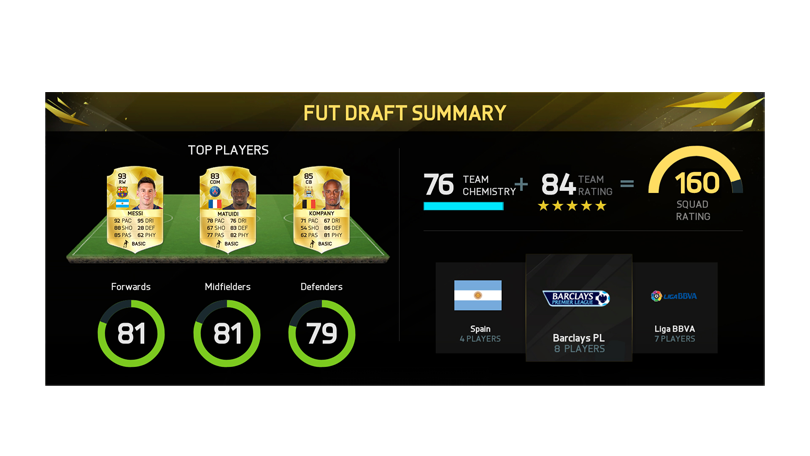
From our experience so far, attempts to put together a Real or a Barça of disparate 'name' players or speed demons could result in something akin to what Stoke City fans have witnessed so far this season. Rein yourself in and look to create something closer to a balanced Crystal Palace or a Swansea, however, and you might find that your team is greater than the sum of its parts.
